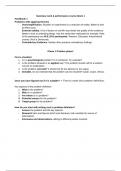Summary
Summary from Theory to intervention - including questions to test your knowlegde
- Course
- Institution
- Book
A summary for the course theory to intervention. In particular, it is a summary of the lectures, since most of the book is already discussed in these. I have read the book and added the information I think is missing from the lectures. I have also provided some exam questions with answers at the bo...
[Show more]




